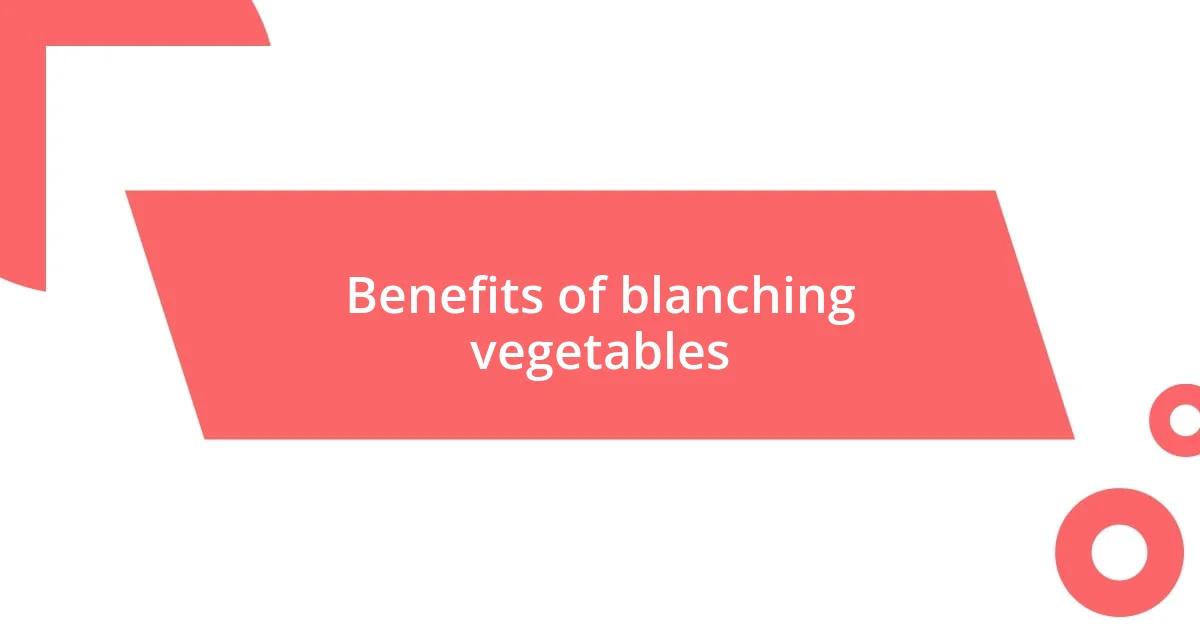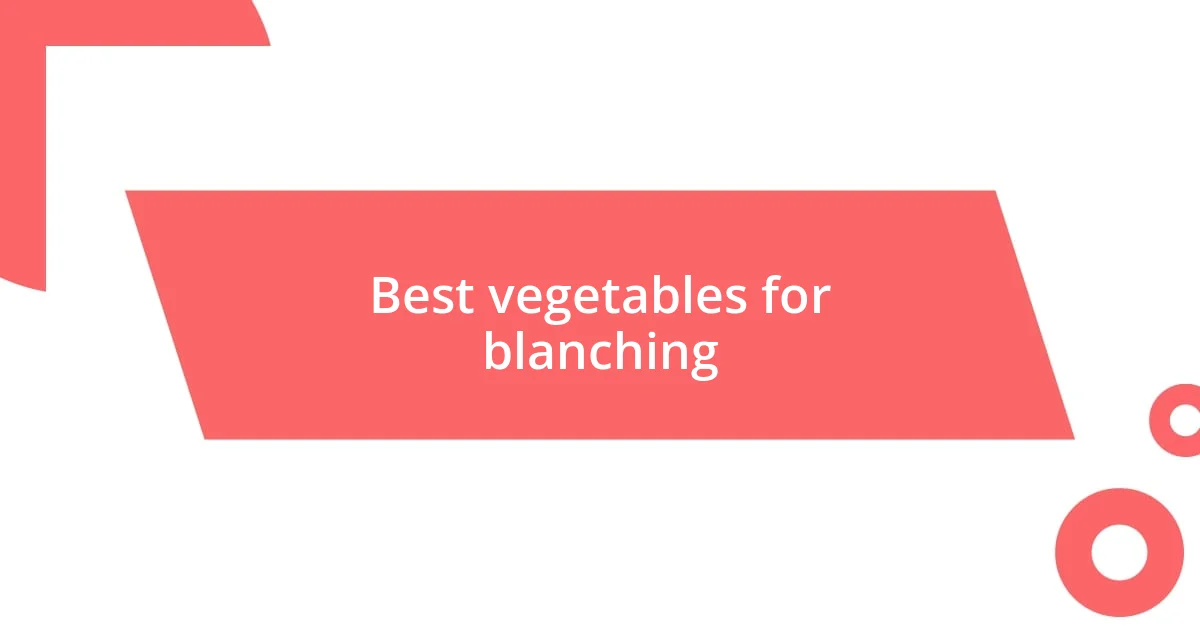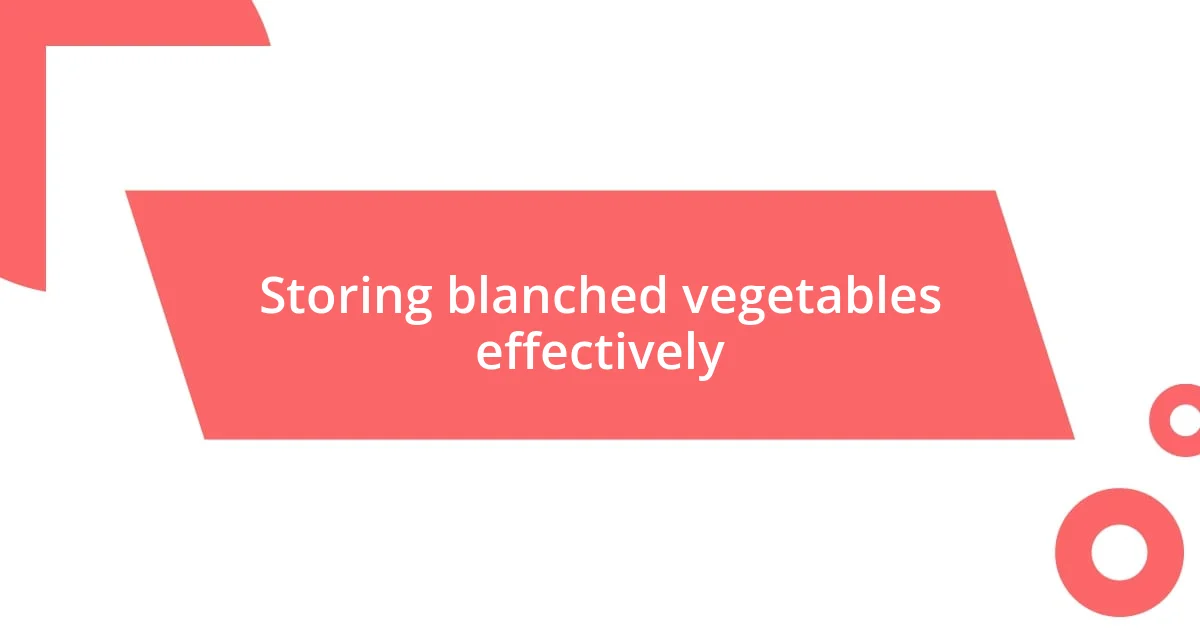Key takeaways:
- Blanching enhances the color, texture, and nutritional value of vegetables through precise timing and technique.
- Common mistakes include overcooking, skipping the ice bath, and overcrowding the pot, which can lead to mushy vegetables.
- Effective storage of blanched vegetables involves thorough drying, using glass containers, and labeling for easy identification and meal planning.

Understanding blanching techniques
Blanching techniques can seem simple at first glance, but they hold the secret to vibrant colors and improved textures in vegetables. When I first tried blanching, it felt like magic watching the fresh green of asparagus brighten in seconds as I plunged it into boiling water. Have you ever experienced that? That’s the moment I realized that blanching not only enhances visual appeal but also preserves that lovely crunch.
The process typically involves boiling vegetables for a short period and then shocking them in ice water. It might sound ordinary, but to me, it was a revelation. I remember mastering the timing for broccoli—just a quick 2-3 minutes and then straight into the ice bath. The satisfaction I felt when those florets emerged bright green and crisp was indescribable. It’s curious how a technique so straightforward can elevate everyday cooking, isn’t it?
Every vegetable has its own ideal blanching time, and getting it right can truly make a difference. I’ve learned, sometimes through trial and error, that overcooking during blanching can lead to mushy veggies that lose their appetizing appeal. Isn’t it fascinating how something as simple as timing can transform your dish? Recognizing those nuances is what makes mastering this technique so rewarding.

Benefits of blanching vegetables
Blanching vegetables offers several remarkable benefits that I’ve come to appreciate over time. One major advantage is that it helps lock in nutrients. When I first learned to blanch spinach, I was amazed that just a minute in boiling water could preserve its vibrant color and vitamins. It felt rewarding to know that my family could enjoy healthy vegetables that didn’t lose their nutritional punch.
Additionally, blanching enhances flavor while reducing bitterness in certain vegetables, like Brussels sprouts. The first time I tried it, I was hesitant but decided to give it a go. After a quick blanching, those little cabbages became tender and slightly sweet—so much better than I ever imagined! It’s these little victories in the kitchen that nourish not just the stomach but also the soul.
Finally, one significant benefit I’ve found is the practicality of blanching for meal prep and freezing. Whenever I batch-cook green beans, I make it a point to blanch them first. This not only keeps them fresh for weeks but also means that when it’s time to cook, I can skip the extra steps and get right to the good part—the eating!
| Benefit | Description |
|---|---|
| Nutrient preservation | Locks in vitamins and minerals, keeping vegetables healthier. |
| Flavor enhancement | Reduces bitterness, making vegetables taste sweeter and more appealing. |
| Meal prep convenience | Facilitates freezing for later use, ensuring veggies last longer. |

Step by step blanching process
To achieve perfect blanching, I follow a straightforward step-by-step process. Each stage is significant, and I’ve discovered that precision really pays off. The first step involves bringing a large pot of water to a vigorous boil. I always remember the look of the steam rising; it builds my anticipation for those fresh veggies. Once the water is ready, I add salt to enhance flavor and color—this little touch makes a visual and taste difference.
Here’s the process I follow:
- Prepare the vegetables: Wash and cut them into uniform pieces, so they cook evenly.
- Boil the water: Use a big pot; the more water, the better the heat intensity.
- Add the vegetables: Carefully plunge them into the boiling water, ensuring not to overcrowd the pot.
- Time it right: Set a timer based on the specific vegetable (for example, 2 minutes for green beans). I can’t stress enough how essential this step is to avoid mushiness.
- Shock them: Transfer the blanched veggies immediately into an ice bath to stop the cooking process.
It can get a bit chaotic with steam and ice water splashing, but it’s all part of the fun. The moment I pull those bright green vegetables from the ice bath, I feel a sense of achievement that fuels my culinary passion.
Now, I’ve learned that the key to perfect blanching lies in attentiveness. Once the vegetables are submerged, I pay close attention to the time. The first time I tried blanching carrots, I was so focused on the process that I forgot to check the clock! They turned out overcooked, turning into a mushy mess. I’ve come to appreciate how that small moment of distraction can change everything. Blanching truly requires engagement, and when done correctly, it’s profoundly satisfying to see those veggies keep their lively color and crispness.

Common mistakes in blanching
Overcooking is probably the most common mistake I see when people attempt blanching. I remember my first go at it; I was so excited to cook broccoli that I lost track of time. Instead of the bright green florets I envisioned, I ended up with a soggy mess. It’s a lesson that has stuck with me—timing is everything. A simple two-minute watch is all it takes to keep vegetables crisp and vibrant.
Another pitfall is skipping the ice bath. I once thought I could just drain the hot water and call it a day. That was a mistake! Without that immediate shock from the cold, my beans continued to cook and lost their beautiful snap. Now, I make it a priority to prepare a big bowl of ice water and know that this leisurely step ultimately elevates my veggies.
Finally, a misstep many of us make is overcrowding the pot. During one particularly ambitious meal prep session, I decided to blanch a mountain of green beans all at once. The pot cooled down too much, and I got uneven cooking. Remembering to give vegetables their space not only helps with cooking evenly but also keeps them from turning into a clump of greens. Who wants that bland pile of mush when we can have neat, crisp veggies?

Best vegetables for blanching
When it comes to blanching vegetables, I find that certain picks simply shine brighter than others. For instance, green beans are my go-to—they transform from a dull green to an eye-popping hue. I can’t help but smile when I see them; that vibrant color inspires my whole dish! Carrots are another favorite. Their sweetness deepens with blanching, and I love that they retain a satisfying crunch, making them perfect for salads.
I also have a soft spot for broccoli. After blanching, it has this lovely bright green that’s just so inviting. I remember the first time I served it to friends; they couldn’t believe it wasn’t frozen! It’s moments like these that spark joy while cooking. Not to mention, snap peas are fantastic candidates as well. They’re crisp and sweet, and blanching right keeps them that way. I often think about how simple it is to elevate a meal by blanching some fresh peas for a pop of color and flavor.
Let’s not forget about leafy greens like spinach. Blanching greatly reduces their volume while intensifying the flavor, making them a quick addition to any dish. The first time I tried blanching spinach, I was amazed at how just a minute in boiling water transformed a hefty pile into a neat serving. It’s fascinating how such a simple process can enhance flavor and texture, isn’t it? Choosing the right vegetables for blanching makes all the difference in creating lively, vibrant dishes that not only taste great but also look appealing on the plate.

Tips for perfect blanching results
When it comes to achieving perfect blanching results, I can’t stress enough the importance of having everything prepped ahead of time. I once had a frantic moment where I realized my water wasn’t boiling while my veggies were waiting to be blanched. That’s when I learned to have my ice bath ready and my vegetables trimmed and rinsed. Being organized not only saves you time but also helps you keep track of those crucial seconds when your vegetables are in the pot.
Another tip I find invaluable is to cut your vegetables into uniform sizes. Remember that time I attempted to blanch asparagus and carrot sticks together? The asparagus cooked faster, and by the time I fished them out, my carrots were still tough. I learned that by chopping my vegetables into similar shapes, I can create a delightful consistency in texture and taste. It’s amazing how something so simple can transform the outcome of your dish!
Lastly, use plenty of salt in your blanching water. Initially, I hesitated, thinking it would add too much flavor, but I was pleasantly surprised at how it enhances the natural sweetness of vegetables. I recall blanched green beans that were so tasty they barely made it to the dinner table! So, why not be generous with that sprinkle? It’s all about elevating your vegetables to that perfect crisp without losing their natural essence. Your palate will thank you!

Storing blanched vegetables effectively
When storing blanched vegetables, timing is crucial. After removing them from the ice bath, I find it essential to dry them thoroughly. One time, I simply dumped them into a plastic bag without patting them down first. The outcome? A soggy mess that lost its crunch and vibrancy. Now, I use a clean kitchen towel to ensure they’re moisture-free before any storage.
I’ve discovered that the choice of storage container significantly impacts freshness. I prefer glass containers with airtight lids. I remember a time when I used plastic, thinking it would suffice, but the vegetables quickly lost their flavor and brightness. The glass method preserves their crispness much longer. The sight of well-stored blanched beans still maintaining their vibrant green is honestly a small victory in my kitchen!
Lastly, don’t forget to label and date your containers. Believe me, I’ve been there—finding random veggies in the back of the fridge months later, forgotten and unidentifiable. A simple label not only saves my sanity, but it also leads to creative meal planning. Isn’t it satisfying to see a well-organized fridge, stocked with colorful, nutritious options ready to be included in your meals? It gives me a sense of accomplishment every time!















